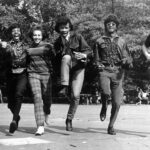Buddy Holly stands as a pivotal figure in music history, and among his impressive catalog of hits, “True Love Ways” shines with a unique and enduring appeal. This ballad, released posthumously, reveals a different facet of Holly’s artistry, moving away from his upbeat rock and roll sound towards a more tender and orchestrated style. It’s a song that not only captures the beauty of true love but also showcases Holly’s vocal talent and evolving musical direction.
The Melodic Beauty and Orchestration of “True Love Ways”
“True Love Ways” is immediately striking for its beautiful melody. It’s a tune that lingers in the mind, evoking feelings of warmth and sincerity. Beyond the melody, the orchestration elevates the song to another level. Recorded during his last studio session, Holly collaborated with Dick Jacobs, who arranged and conducted a full orchestra. This marked a significant departure from Holly’s earlier recordings and hinted at a potential new direction in his music. The use of eight violins, violas, cellos, guitar, bass, piano, harp, saxophone, and drums creates a rich and moving soundscape that perfectly complements the song’s heartfelt lyrics. The saxophone solos, played by the seasoned Abraham “Boomie” Richman, add a particularly poignant touch to the overall arrangement.
Buddy Holly’s Vocal Performance: A Testament to His Skill
Beyond the instrumentation, “True Love Ways” highlights Buddy Holly’s exceptional vocal performance. The song demands a different kind of delivery than his rock and roll hits, and Holly rises to the occasion with grace and emotion. His characteristic vocal qualities are on full display, imbued with a tenderness and vulnerability that enhances the song’s romantic theme. It’s a performance that reveals his versatility as a vocalist and his ability to connect with listeners on a deeply emotional level.
A Song Born of Love: The Story Behind “True Love Ways”
The personal story behind “True Love Ways” adds another layer of depth to its appeal. Buddy Holly wrote this song as a wedding gift for his wife, Maria Elena Santiago Holly. Their whirlwind romance, from meeting at a music publishing office to getting engaged on their first date and marrying just two months later, is itself a testament to true love. Knowing this context enriches the listening experience, transforming the song into a personal declaration of love from Holly to his wife.
The Last Recording Session and Its Significance
The recording session for “True Love Ways” on October 21, 1958, is particularly poignant as it was Buddy Holly’s last. Alongside “True Love Ways,” this session also produced other classics like “It Doesn’t Matter Anymore” and “Raining in My Heart,” further cementing its importance in music history. This session at Decca’s Pythian Temple studio is seen by many as a turning point, suggesting Holly was moving towards a more mature and orchestrated sound. The fact that “True Love Ways” wasn’t released until after his death, on the posthumous album The Buddy Holly Story, Vol. 2 in March 1960, only adds to its legendary status.
The Enduring Legacy and Influence of Buddy Holly
Tragically, Buddy Holly’s life was cut short in a plane crash on February 3, 1959, a day forever known as “The Day the Music Died,” immortalized in Don McLean’s “American Pie.” Despite his short career, Holly’s influence on music is undeniable. He is credited with popularizing the classic rock band lineup of two guitars, bass, and drums. His impact resonated deeply with future music icons. The Beatles, heavily influenced by Holly and The Crickets (even adopting a similar insect-themed band name), drew inspiration from his music and stage presence. Paul McCartney’s ownership of Holly’s song catalog further underscores this connection. Bob Dylan, who saw Holly perform just days before his death, and Mick Jagger of The Rolling Stones, who was inspired by Holly’s performance of “Not Fade Away,” are just a few of the many artists who acknowledge Holly’s profound influence on their musical journeys.
“True Love Ways” and its Many Renditions
The broad appeal of “True Love Ways” is evident in the sheer number of cover versions recorded over the decades. Artists from various genres have interpreted the song, each bringing their own style to this classic. Notable covers include versions by Bobby Vee, Frank Ifield, Peter & Gordon, Skeeter Davis, Gary Busey (for The Buddy Holly Story soundtrack), Mickey Gilley, Cliff Richard, Erasure, Martina McBride, and many more. This extensive list of covers demonstrates the timeless quality of “True Love Ways” and its ability to resonate with different generations and musical tastes. Whether it’s a straightforward vocal rendition or an instrumental interpretation, the beauty of “True Love Ways” continues to shine through.
Notable Releases and Versions of “True Love Ways”:
- Buddy Holly (1960)
- Bobby Vee (1963)
- Frank Ifield (1964)
- Peter & Gordon (1965)
- Tommy Allsup (1965) – instrumental
- Skeeter Davis (1967)
- Gary Busey (1978)
- Mickey Gilley (1980)
- Cliff Richard (1983)
- Erasure (2003)
- Martina McBride (2005)
- Jackson Browne (2011)
- Military Wives (2012) – choral
In conclusion, “True Love Ways” is more than just a song; it’s a testament to Buddy Holly’s musical genius and his capacity to evolve as an artist. Its beautiful melody, moving orchestration, and heartfelt story continue to captivate listeners, solidifying its place as a timeless classic and a standout Buddy Holly Song in his remarkable repertoire.


